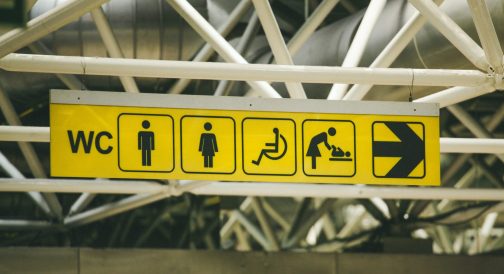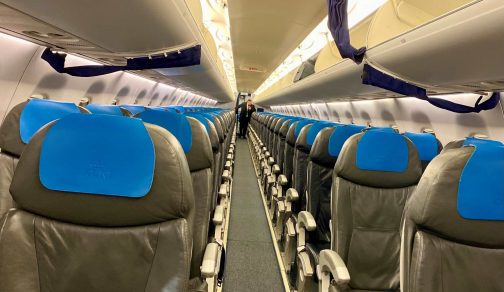Part 2: steering my disabled body through an able-bodied world
Matthew Savage reflects upon his experience as a disabled wheelchair user in a world which was neither designed nor built for him.
Doors
Why is every physical space, including our schools, in need of liberation? Let’s start with doors. Beyond the safe and known confines of our Highlands bungalow, I navigate any internal or external space in my electric wheelchair. The ‘door’ is a convenient metaphor for the portal to any community of power (we talk about getting our ‘foot in the door’, for example); but that portal, for me, is literal. If I want to enter or exit any building, or room therein, I am typically faced with a heavy, handled, hinged, outward-opening door, despite the fact that the only door that is easy and safe to open in a wheelchair is a sliding door, manual or, better still, mechanised.

The dishonesty of the ‘accessible bathroom’ sign
This challenge is everywhere, in many an ‘accessible’ hotel bedroom (which is only accessible after the door has been opened), and especially so when I want to enter an ‘accessible’ bathroom. Before using almost any public bathroom, I have had to ask a stranger if they would open the door for me. As someone who does not believe students should have to ask for permission to use the bathroom, I certainly do not think I should have to do so myself. To add insult to injury, many an accessible bathroom does not provide sufficient turning space either; and flying out of one airport recently, I was told there was no accessible bathroom available at all.
As a consequence, I commonly try to minimise my fluid intake when out of my house, so that I do not have to suffer the indignity of a bathroom whose ‘accessibility’ is but a mirage, a performative badge that may tick boxes but does not liberate the disabled user. This is not to mention the bizarre requirement in many a public space that a wheelchair user report to a member of staff to collect, and return, the special bathroom key. I recognise this is to ensure able-bodied users do not occupy this targeted space – but, again, the design, much as it may seek to liberate, does anything but.
Airports and flying

Matthew working face-to-face recently with students from the Australian International School Saigon
Whilst I love the success with which Zoom masks my disability, I love my face-to-face work. Norah Bateson calls this aphanipoiesis, the communing and commingling of multiple stories in a submerged, liminal space from which could eventually emerge a seedling of hope. And for me, professionally, nothing compares to this; how fortunate am I that the pandemic lifted its pall such that I can safely travel around the world again. And yet each flight, or succession thereof, treads on my agency and dignity, and my comfort and safety, at every juncture.
The system through which one requests special assistance when booking a flight varies between airlines in all but one thing: its complexity. Even airlines which build it into the booking process rarely pass this information on to the check-in staff, leaving me having to explain my medical condition and requirements again, all in earshot of an increasing, and increasingly irritated queue. And most airlines require persistent and repeated phonecalls and emails to secure a promise only that they will endeavour to provide said assistance.
I used to rely on the airport wheelchairs, but the understaffing of the privatised assistance teams, and the fact that most airport wheelchairs are not self-propelling, too often left me stranded in a corner for hours, without access to food, water or a bathroom. Therefore, I invested in a foldable, electric wheelchair, which is now, to all intents and purposes, my legs, and I manage, despite numerous objections, to take it to the plane door, although never on to the plane itself. I am always promised that it will be returned to the door on landing; but, on landing, I am commonly told that it has been “lost”, panic setting in until it is discovered again, often scratched or dented, somewhere in the baggage hall.
Going through security in a wheelchair is, at best, undignified and, at worst, invasive. Even on the few occasions when the policy states disabled passengers board first, boarding is still a spectacle, whether my seat is close enough to the door to use my crutches or I have to be strapped into the onboard wheelchair; and I still don’t understand why there is a step from the gangway to the plane itself. The safety instructions, written or spoken, never mention someone like me, and my crutches are routinely confiscated, retrieving them, should I need the (inaccessible) bathroom, time-consuming and laboursome.

A recent, and typical scene, waiting often up to an hour after others have disembarked the plane
And it is not uncommon for me to remain on board for up to an hour after everyone else has disembarked, the crew for the following flight patiently caring for me until assistance has arrived. Every flight I take takes away a little part of me, and I am lesser forever thereafter. And yet, with intentionality, consultation and compassion, air travel is a space that could easily be liberated. The likes of Sophie Morgan fight this fight on my behalf; I used to give feedback myself, but nothing ever changed, and we still hear of shameful incidents like this with alarming frequency.
Pavements, sidewalks and curb cuts
I love curb cuts. Designed in California by Ed Roberts and others in the 1950s and 1960s, they took one of the discriminating spikes of hostile architecture, and literally excised it to create a ramp that directly benefits people like me, but from which everyone else also benefits. Such a powerful idea is this that I use its metaphorical equivalent as one of the instruments of equity and justice through which every aspect of the school experience can be adapted for universal belonging.
However, whenever I navigate the pavements of a city, I have learned not to depend upon the existence of the actual curb cuts which would enable me to move, unencumbered, through those built environments. The only city where I have not faced this difficulty was Amsterdam, but this is because of the prevalence, far further up the food chain, of the bicycle; the wheelchair was an afterthought. I often talk to schools about the tussle, in any practice, between coincidence and consistency, and this is, fundamentally, an equity issue. The same is true for the humble curb cut.
In London recently, I selected a restaurant based on its social media and website having declared it fully accessible, only to arrive and find there was a step to enter the premises. This is not just frustrating; it is humiliating, distressing, and infuriating. The step may as well be a brick wall. Then there is the construction work which has temporarily diverted pedestrians on to the road, but without a ramp to cut that curb. And on a recent train journey, a step-free station was closed, which meant I had to ask several strangers to lift me, on my wheelchair, from the train at the next station.
Ramps
Which brings me to the ramps, installed or designed with the best intentions, deliberate acts of inclusion, whose gradient is simply too steep to carry my wheelchair safely upwards. On at least three occasions this year, it is only the sharpest reflexes of a group of adults coincidentally nearby that prevented my wheelchair tipping backwards and sending me tumbling to likely serious injury below. Or the promised ramps which, for whatever reason, did not materialise, leaving me depending, again, on others, this time to lift me up the steps to the upper level. And for a rooftop, conference dinner in January, I had to be physically carried up three narrow flights of stairs even to participate.
Liberating spaces
When I read this article myself, it seemed like a long list of complaints, and I would hate to seem like the kind of person who only complains. However, try as I might to remain positive, the built world is not designed for people like me. As the late, great, Stella Young – comedian and disability-rights campaigner – said, “No amount of smiling at a flight of stairs has ever made it turn into a ramp.”
This is why I was so determined to bring to life, with tp bennett architects and ECIS, the ‘Liberated School Spaces’ conference that took place in London in November 2023. What a wonderful, and wonderfully inclusive, event it was: empty of complaints, full of solutions, and brimming with hope instead. I cannot wait for the white paper we are releasing in January, and for ‘Liberated School Spaces 2.0’ later in the year. So watch this liberated space!
 A proud member of ECIS’ DEIJ team, Matthew Savage is an experienced, international school principal, governor, speaker, coach and consultant, helping leaders, educators and students worldwide, through The Mona Lisa Effect®, help ensure that every child, without condition or exception, can “be seen, be heard, be known and belong”. He lives on the Isle of Skye, with his wonderful wife and atypical dog.
A proud member of ECIS’ DEIJ team, Matthew Savage is an experienced, international school principal, governor, speaker, coach and consultant, helping leaders, educators and students worldwide, through The Mona Lisa Effect®, help ensure that every child, without condition or exception, can “be seen, be heard, be known and belong”. He lives on the Isle of Skye, with his wonderful wife and atypical dog.
This is Part 2 of an article originally published on ECIS’ ‘Insightful’ blog.
See Part 1 here:
FEATURE IMAGE: The Isle of Skye by M W from Pixabay
Support Images: Kindly provided by Matthew

